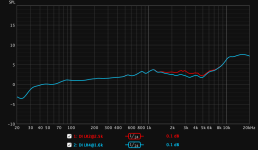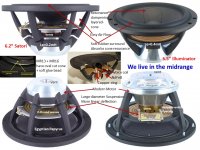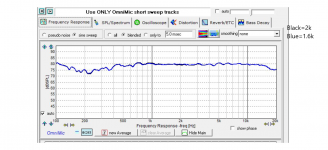I am looking for opinions regarding the SB Acoustics MR16P 6 inch midrange driver and the ScanSpeak 18M-4631T 6.5 inch midrange driver.
I am looking for both subjective evaluations and objective comparisons (beyond what can be obviously determined be examinin the spec sheets...)
I intend to use these drivers from 200 Hz to 1.6 kHz in an active 3 way.
The SS 18M is about $220 while the SB MR16 is about $150. I want to understand if the SS 18M offers performance which would have value in my application.
I am looking for both subjective evaluations and objective comparisons (beyond what can be obviously determined be examinin the spec sheets...)
I intend to use these drivers from 200 Hz to 1.6 kHz in an active 3 way.
The SS 18M is about $220 while the SB MR16 is about $150. I want to understand if the SS 18M offers performance which would have value in my application.
Attachments
"I intend to use these drivers from 200 Hz to 1.6 kHz in an active 3 way."
6" Satori MR16P-4 test results from Nelson Pass: "Very impressed with the sound of this midrange."
A great choice for your selected sealed volume 200Hz up to 1,600Hz - 1,900Hz frequency range.
Can you post your cabinet design and what tweeters you are considering? Goals for directivity control and room interaction?
-----
The Satori MW16P-4 is the better sealed volume midrange choice when a lower 100-150Hz crossover is selected.
6" Satori MR16P-4 test results from Nelson Pass: "Very impressed with the sound of this midrange."
A great choice for your selected sealed volume 200Hz up to 1,600Hz - 1,900Hz frequency range.
Can you post your cabinet design and what tweeters you are considering? Goals for directivity control and room interaction?
-----
The Satori MW16P-4 is the better sealed volume midrange choice when a lower 100-150Hz crossover is selected.
Attachments
For a tweeter I was leaning toward the Scanspeak D2905-95000.
Here is a description of my system as of today...
New active 3-Way, Hypex and SB
I am in the planning stage of the next step in evolution. I want to make a second set of satellites. So I am guessing a 10 to 15 liter box, heavilly rounded / bevelled baffle similar to what I have now. The box design will depend on which midrange/ midwoofer I pick.
Here is a description of my system as of today...
New active 3-Way, Hypex and SB
I am in the planning stage of the next step in evolution. I want to make a second set of satellites. So I am guessing a 10 to 15 liter box, heavilly rounded / bevelled baffle similar to what I have now. The box design will depend on which midrange/ midwoofer I pick.
I have the Satori MR16 4 Ohm midrange. It sounds great but I think the SS can take a whole lot more power. I had a 2nd order HP on the MW16 in a closed box; X/O about 225 Hz. I don't know for sure but even then; system power peaks above 50 Watts are too much for it (not measured; just an educated guess). If you don't need real loud or you cross higher; the Satori is a good choice for sure.
Another option is the MW16 mid-woofer. It can take more power in my same above configuration and if you cross between 1000 and about 1500 Hz; the two Satoris sound VERY similar. The MW does bass better and the MR does mids better; no surprise as that is exactly what they were designed to do. For more SPL or power handling; go for the SS. Another possible option is the Wavecor Balanced Drive (BD) series. I have seen only a very few reviews but many prefer them to SS, Seas, Satori, etc. (I have a Wavecor WF223BD01 on order to replace my Satori MW16...I needed more power handling and SPL in the 200 to 800 Hz band)...
Keep us informed; I'm curious what you decide on...
Another option is the MW16 mid-woofer. It can take more power in my same above configuration and if you cross between 1000 and about 1500 Hz; the two Satoris sound VERY similar. The MW does bass better and the MR does mids better; no surprise as that is exactly what they were designed to do. For more SPL or power handling; go for the SS. Another possible option is the Wavecor Balanced Drive (BD) series. I have seen only a very few reviews but many prefer them to SS, Seas, Satori, etc. (I have a Wavecor WF223BD01 on order to replace my Satori MW16...I needed more power handling and SPL in the 200 to 800 Hz band)...
Keep us informed; I'm curious what you decide on...
The 9500 was a great tweeter 20 years ago, but it's outclassed by a large number of tweeters these days. If you want to use a large mid, the DI mis-match at the crossover could use some addressing. The preferred option these days is to use a waveguide on the tweeter, but if you don't want a waveguide for whatever reason, a shallower slope will blend the two drivers over a farther region. Here are the measured DIs for my speakers using an 18M-4631 and D3304/6640 into lower/steeper and higher/shallower crossovers.

The LR2@2.5k is far from perfect, but is an improvement. I had intended to keep pushing the crossover point lower (and possibly steeper) until the tweeter started to distort, but ended up going the opposite route.
If you use a waveguide, then you can stick with lower/steeper and avoid the breakup on a stiff mid. If you go higher/shallower, then you need wide bandwidth drivers, no breakup on the mid, and sufficient excursion for the tweeter.
If by "monitors" you mean stand-mount 2-way (and don't want a waveguide) then consider using a robust 5" for wider dispersion at crossover and decent bass e.g. the old Revelator 5" which is still competitive and I still like the way it looks.
If you are a fan of fugly, then look at the new Purifi drivers. They have a larger midwoofer that pairs nicely with a waveguide, and a tiny one that is probably only worthwhile in a tiny 2-way. Otherwise the excursion is unwarranted and there are other dedicated mids that are also good.
If you are going to do a 3-way, then Satori MR13 are pretty great.

The LR2@2.5k is far from perfect, but is an improvement. I had intended to keep pushing the crossover point lower (and possibly steeper) until the tweeter started to distort, but ended up going the opposite route.
If you use a waveguide, then you can stick with lower/steeper and avoid the breakup on a stiff mid. If you go higher/shallower, then you need wide bandwidth drivers, no breakup on the mid, and sufficient excursion for the tweeter.
If by "monitors" you mean stand-mount 2-way (and don't want a waveguide) then consider using a robust 5" for wider dispersion at crossover and decent bass e.g. the old Revelator 5" which is still competitive and I still like the way it looks.
If you are a fan of fugly, then look at the new Purifi drivers. They have a larger midwoofer that pairs nicely with a waveguide, and a tiny one that is probably only worthwhile in a tiny 2-way. Otherwise the excursion is unwarranted and there are other dedicated mids that are also good.
If you are going to do a 3-way, then Satori MR13 are pretty great.
I am attracted to the D2905-95000 because of its very low Fs and its low distortion down to 1000 Hz. I want to use a crossover in the range of 1.6 kHz, so low Fs and low distortion in this region seem pretty important. The modest $140 price is also attractive.
Are there other tweeters I should be considering... ???
Regarding waveguides: I am still studying wave guides, and I am not ready to build anything with waveguides yet.
Are there other tweeters I should be considering... ???
Regarding waveguides: I am still studying wave guides, and I am not ready to build anything with waveguides yet.
SBA/Satori have a lot of tweeters that provide too many variations on a few themes for me to remember which is which, but they have options <=$150 that have flat response <2kHz which makes a low passive crossover easier. Active and you have more flexibility with crossover point. Plus you already know you like the brand.
Hificompass.com is a good site for comparing measurements of recent products. For older tweeters (including the 9500), you can look at Zaph's site, but you have to compare within each site and not between sites because the conditions will be different.
Hificompass.com is a good site for comparing measurements of recent products. For older tweeters (including the 9500), you can look at Zaph's site, but you have to compare within each site and not between sites because the conditions will be different.
Agreed on that.Crossing SS 2905/950000 at 1.6kHz is too low
Take a look at this SB:
SB Acoustics SB26STWGC-4 Fabric Dome Tweeter with Wave Guide
While I applaud bringing a tweeter with integrated waveguide to market, it looks like they tried to fit the standard 104mm faceplate, which limited other considerations. I would rather see the waveguide shallower and wider so there is less directivity, but extends lower. This looks like it requires a too high of a crossover point (~3.5kHz) to match DI to a mid. The not-yet-released TW29BNWG-4 looks like it might fit that description.
I appreciate everyone's thoughts. Thanks, it helps clarify my thinking.
Several folks have mentioned that they thought that crossing the D2905 at 1.6k was too low.
For comparison, I currently use an SB 26CDC-C004 crossed at 2 kHz. It has an Fs of 690 Hz, which is a ratio of 2.9 between Fs and F-xover. Applying a similar ratio to the D2905 which has an Fs of 550 Hz results in 1594 Hz.
In fact, I have experimented with crossing my SB 26CDC tweeter as low as 1.6 k. There was practically no difference in frequency response, and I could not tell any difference in critical listening. Shown below is the Frequency response plot, black is 2k crossover, blue is 1.6k crossover. Also shown is two distortion plots... the first is for the 2 k crossover (HD-P1.pdf), the second is for a 1.6 k crossover (HD-P3.pdf). Virtually no difference in distortion. So from my perspective, it seems both safe and appropriate to cross the D2905 at 1.6 k.... am I missing something?
Several folks have mentioned that they thought that crossing the D2905 at 1.6k was too low.
For comparison, I currently use an SB 26CDC-C004 crossed at 2 kHz. It has an Fs of 690 Hz, which is a ratio of 2.9 between Fs and F-xover. Applying a similar ratio to the D2905 which has an Fs of 550 Hz results in 1594 Hz.
In fact, I have experimented with crossing my SB 26CDC tweeter as low as 1.6 k. There was practically no difference in frequency response, and I could not tell any difference in critical listening. Shown below is the Frequency response plot, black is 2k crossover, blue is 1.6k crossover. Also shown is two distortion plots... the first is for the 2 k crossover (HD-P1.pdf), the second is for a 1.6 k crossover (HD-P3.pdf). Virtually no difference in distortion. So from my perspective, it seems both safe and appropriate to cross the D2905 at 1.6 k.... am I missing something?
Attachments
Your current active speakers should sound excellent.
(Hypex Fusion FA253 amps + SB34NRX75-6 + SB17CAC35-4 + SB26CDC-C000-4)
For your next design, have you considered experimenting with the combination of high dynamics and controlled directivity from horn/waveguide/synergy designs? You can use your FA253 amps for early experiments. Sketch your room to determine the best placement, and set the maximum cabinet width which fits into your room. Common widths: 14-15" with SEOS12 / H290C / LTH102, or 16" -18" with SEOS15 / B-52 PHRN-1014, or 26" with SEOS24 / Synergy.
---------------------------
Do you want to see examples?
(Hypex Fusion FA253 amps + SB34NRX75-6 + SB17CAC35-4 + SB26CDC-C000-4)
For your next design, have you considered experimenting with the combination of high dynamics and controlled directivity from horn/waveguide/synergy designs? You can use your FA253 amps for early experiments. Sketch your room to determine the best placement, and set the maximum cabinet width which fits into your room. Common widths: 14-15" with SEOS12 / H290C / LTH102, or 16" -18" with SEOS15 / B-52 PHRN-1014, or 26" with SEOS24 / Synergy.
---------------------------
Do you want to see examples?
Do you want to see examples?
Yes I would. I have to admit that I have been somewhat overwhelmed in trying to play "wave guide catch-up"... it seems everyone who is into wave guides is well ahead of me.
For my second iteration, I really want to see what a paper cone mid and soft dome tweeter sound like. I want to compare them to the ceramic/aluminum drivers I have now. I want to stick with a low diffraction baffle design with a wide smooth dispersion.
Eventually I want to try a wave guide tweeter, but I am still learning.
There isn't much of a correlation between Fs and distortion-based HP frequency selection, and certainly is no causation between the two. Try it out and see how you like it (after you check out the relevant distortion measurements, of course).I appreciate everyone's thoughts. Thanks, it helps clarify my thinking.
Several folks have mentioned that they thought that crossing the D2905 at 1.6k was too low.
For comparison, I currently use an SB 26CDC-C004 crossed at 2 kHz. It has an Fs of 690 Hz, which is a ratio of 2.9 between Fs and F-xover. Applying a similar ratio to the D2905 which has an Fs of 550 Hz results in 1594 Hz.
As for the drivers, I would suggest the giant-slayer SB17NAC35/SB17NBAC35 (hereafter referred to as "SB"). Within that passband, the SB's HD performance matches, if not betters, the superior driver of your original selection (the SS), and has a better CSD, at a significantly lower price point.
A few notes:
- the SB has a flatter frequency response which may or may not be an advantage depending on your crossover topology. if you're doing textbook filtering then the SB is probably better for you
- the SS is more sensitive than the SB, even comparing at the same impedance rating, so you'll need more power for the SB
- at ~92 dB @ 1m, the SS has an advantage in HD3 around 200 Hz, the SB17 has the advantage at 1 kHz and above for HD3 (I give the win to SB17 for HD at this SPL)
- the SS has a slight advantage over the SB17 around 200 Hz at ~98 dB @ 1 m, but if you are using a filter that gives you -6 dB at the crossover point, the SB17 will still be able to maintain the -80 dB HD5 trend and so I would call it even between the two drivers at this output level. the SS doesn't get any appreciable edge from the crossover dip.
- my comments are made based on HiFiCompass measurements
Conclusion: save the money and put it towards lower-hanging fruit, like a deader enclosure, diffraction control, or room treatment
EDIT: Sorry, didn't see that you want to try something other than metal cone drivers
A few notes:
- the SB has a flatter frequency response which may or may not be an advantage depending on your crossover topology. if you're doing textbook filtering then the SB is probably better for you
- the SS is more sensitive than the SB, even comparing at the same impedance rating, so you'll need more power for the SB
- at ~92 dB @ 1m, the SS has an advantage in HD3 around 200 Hz, the SB17 has the advantage at 1 kHz and above for HD3 (I give the win to SB17 for HD at this SPL)
- the SS has a slight advantage over the SB17 around 200 Hz at ~98 dB @ 1 m, but if you are using a filter that gives you -6 dB at the crossover point, the SB17 will still be able to maintain the -80 dB HD5 trend and so I would call it even between the two drivers at this output level. the SS doesn't get any appreciable edge from the crossover dip.
- my comments are made based on HiFiCompass measurements
Conclusion: save the money and put it towards lower-hanging fruit, like a deader enclosure, diffraction control, or room treatment
EDIT: Sorry, didn't see that you want to try something other than metal cone drivers
Last edited:
- Status
- This old topic is closed. If you want to reopen this topic, contact a moderator using the "Report Post" button.
- Home
- Loudspeakers
- Multi-Way
- SB MR16P-8 compared to ScanSpeak 18M-4631t


